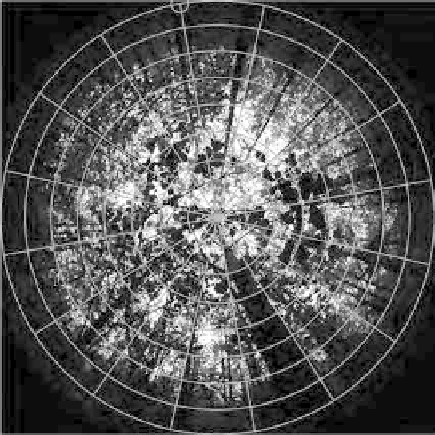Geoscience Reference
In-Depth Information
Figure 4.5
Sky-sector mapping using GLA image analysis software. Eight zenith by 18 azimuth sectors are
shown.
crown), whorls, branches, and shoots. The TRAC instrument was developed at the Canada Centre
for Remote Sensing (CCRS) to address canopy nonrandomness (Chen and Cihlar, 1995). In the
APB study, hemispherical photography (L
) and TRAC measurements (foliage clumping index)
were combined to provide a better estimate of LAI following the method of Leblanc et al. (2002).
e
4.2.4
Satellite Data
MODIS was launched in 1999 aboard the NASA Terra platform (EOS-AM) and in 2002 aboard
the Aqua platform (EOS-PM) and provides daily coverage of most of the earth (Justice et al., 1998;
Masuoka et al., 1998). MODIS sensor characteristics include a spectral range of 0.42 to 14.35
m
in 36 spectral bands, variable pixel sizes (250, 500, and 1000 m), and a revisit interval of 1 to 2
days. Landsat Enhanced Thematic Mapper Plus (ETM
m
) images were acquired at various dates
throughout the year and were used for site characterization and in subsequent analysis for linking
field measurements of LAI with MODIS LAI. ETM
+
+
data characteristics include a spectral range
m; pixel sizes of 30 m (multispectral), 15 m (panchromatic), and 60 m (thermal);
and a revisit interval of 16 d. They also play a vital role in linking meter-scale
of 0.45 to 12.5
m
in situ
LAI
measurements with kilometer-scale MODIS LAI imagery.
IKONOS is a high-spatial-resolution
commercial sensor that was launched in 1999 that provides 4.0-m multispectral (four bands, 0.45
to 0.88
m
m) and 1-m panchromatic data (0.45 to 0.90
m
m) with a potential revisit interval of 1 to 3 d.
4.2.5
MODIS LAI and NDVI Products
Numerous land, water, and atmospheric geophysical products are derived from MODIS radiance
measurements. Two MODIS land products established the primary time-series data for this research:
NDVI (MOD13Q1) (Huete et al., 1996) and LAI/FPAR (MOD15A2) (Knyazikhin et al., 1999). The
NDVI product was a 16-d composite at a nominal pixel size of 250 m. The LAI product was an 8-
d composite product with a pixel size of 1000 m. Both products were adjusted for atmospheric effects
and viewing geometry (bidirectional reflectance distribution function, BRDF). The NDVI product
used in this study was produced using the standard MODIS-NDVI algorithm (Huete et al., 1996).

















